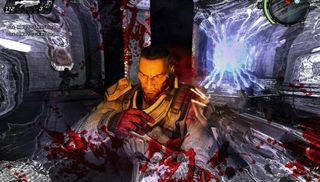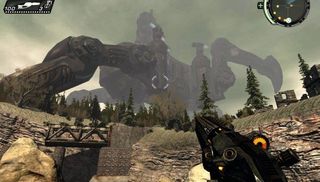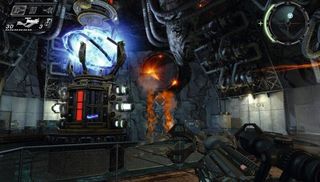Sci-fi FPS TimeShift was saved by a gimmick that was aptly timeless
Reinstall.

Reinstall invites you to join us in revisiting classics of PC gaming days gone by. This time, Marsh Davies pauses to appreciate sci-fi FPS TimeShift.
"Does anyone give a shit about TimeShift?" asks acting editor Chris Thursten, poised to deny my Reinstall pitch. "It doesn't grab me off the bat. I want something that grabs my bat, Marsh."
I can forgive Chris his ungrabbed battitude. TimeShift is an ugly also-ran sci-fi shooter of little acclaim, the troubled production of which is etched into every hastily up-res'd texture. It does not grab bats. It couldn't grab a bat if both it and the bat were made out of magnetised velcro. In fact, when I played it back in 2007, I imagined I would quickly forget it. But I have not.
Every time I play a modern military man-clicker with its succession of glumly trammelled arenas, the memory of TimeShift resurfaces. Instead of the tedious, timid exchange of bullets from cover, wouldn't every firefight be more fun if I could pause time, dash into the fray, plug everyone with an explosive bolt and then watch them disassemble as time resumes? The answer is nearly always yes. TimeShift knew this, which is why, despite its many flaws, it clings to one of the most redeeming, energising and enduring gimmicks in FPS history.
TimeShift was born into an era of shooters that had grown desperate. The notion that your game could stand out by dint of its wacky weaponry alone had been largely played out, and subsequent shooters were flailing wildly for some further innovation. TimeShift didn't quite manage even that: its tawdry time-travel plot hurtles you into an alternative future in which a dystopian regime is in the process of crushing rebellion, while your nemesis, Dr Krone, burbles propaganda from giant flickering screens. The similarities to Half-Life 2 are hardly flattering for the later game.

TimeShift even has a driving section set in the wilderness, but you never find yourself unsaddled by a desire for exploration. That Dr Krone lives in a giant robot spider is not a persuasive addition to the formula.
TimeShift's art style is unique, but for all the wrong reasons: a clumsy amalgam of a partly-aborted steampunk prototype and the grimy Gears of War zeitgeist. It smacks of an 11th-hour publisher panic attack. The HD era seems to have caught the developers on the hop, leading to a crude bumpmap pebbledashing of bleary brown textures. Even the trio of time-bending powers you possess—slow, pause and reverse—can't quite claim novelty, having been glimpsed before in FEAR and Prince of Persia: The Sands of Time. Nonetheless, TimeShift's deployment of them is unusually graceful, honing them to fit the task at hand, balancing their potency against your character's fragility and the sheer number of opponents you face.
PC Gamer Newsletter
Sign up to get the best content of the week, and great gaming deals, as picked by the editors.

This is made obvious in the opening section, where you're without any time abilities at all. It's hard. Tackling just two enemies at once is foolhardy, and TimeShift you to play extremely conservatively, retreating into cover and taking pot shots when you can. Then, blessedly, you're given all your powers at once, and combat opens up into wide arenas that both indulge your supremacy and test your vulnerabilities.
Since you die so easily and later weapons like the Thunderbolt crossbow kill enemies with a single hit, firefights resist Call of Duty's wack-a-mole-with-guns template. Instead, you assess the situation, find the optimum tactical placement amid your foes, and weigh your diminishing timepower pool against the reload speed of your weapon. Reaching that sweet-spot that gives you the maximum sightlines, and skewering each foe in turn before the ticker runs out, transforms this shooter into something more like Power Snooker.
This is so reliably entertaining that TimeShift is almost undone by it. Once the Thunderbolt falls into your hands it rarely leaves them, and the rest of the exotic arsenal barely gets a look in. There's an Uzi with a flamethrower attachment, a plasma rifle that fires arcing explosive projectiles, and a cannon capable of emitting a deadly beam of blue energy, but none will lever you out of the Thunderbolt groove.

Instead, variety is forced by the ratcheting power of your opponents. Since the ordinary grunts can still cut you down in open ground, enemies try to force you out of cover or keep your time powers depleted. Jetpacking goons easily get the drop on you, while those wielding energy shields can only be defeated by stopping time altogether—a much more expensive manoeuvre than simply slowing it. Later, vat-born supersoldiers enact their own time powers, appearing to zip through the level in an impossible blur, forcing you counter with your own abilities. The lethality of failure would be a chore if the game didn't support quicksaves—but it does, letting you experiment with brash tactics.
For all this, TimeShift still exhausts what novelty it has. The smattering of time-based puzzles, which require you to freeze giant rotating fans or reverse the movement of a conveyor belt, rarely explore the gimmick's potential. But its merits have only become more significant since release: the devastating success of Call of Duty stifled the impetus for shooters to be mechanically experimental or playful. BioShock, BulletStorm and Singularity are notable exceptions. And so it is that an often mediocre game from 2007 remains a champion of progress within the shooter genre—of consistent, systemic, tactically rejuvenating game mechanics. It may be flailing for a unique selling point, but with the latest comatose campaigns for CoD and Battlefield as grim testament, the FPS could do with a bit more flailing. You can't grab anyone's bat unless you reach for it.
Most Popular

